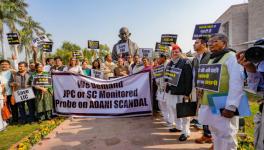Why Do the Woes of Dalits in Punjab Remain Ignored?
Image for representational use only.Image Courtesy : Scroll
Surinder Singh, in his brown T-shirt and soiled pants, throws a disgruntled look at a vehicle campaigning for the Congress candidate from Gurdaspur, veteran leader Sunil Jakhar. To take on the Congress, the Bharatiya Janata Party has fielded actor turned politician 62-year-old Sunny Deol.
“Tussi dasso ki hona chaida haan (You say what should be happening). I have no land to grow crops. I have a ration card. I get 7kg of grains per person per month but the supply remains inconsistent and I depend on the market to survive. After years of struggle, I have bought this vehicle and this is the sole asset I own,” he says.
Singh finally reveals that he is a dalit belonging to Ravidassia community. Apart from Sikh Jats and Christians, it is dalits like Surinder Singh who constitute a significant chunk of the voters who decide the fate of candidates in elections. Newsclick travelled to Gurdaspur to take a look at the problems faced by dalits in the state and their views on the elections.
Dalits constitute 32 per cent of the population of Punjab. Despite the mammoth size, dalits still lack significant representation in the polity of the state. But the dalits living in the bordering areas of Punjab have a unique problem.
After insurgency hit the border state in eighties, industries fled on a mass scale followed by consistently rising tensions with Pakistan. Filled with anxiety and insecurity, the land-owning population started moving to the USA, Canada and other countries. However, dalits in bordering areas remain untouched by this phenomenon.
Also see: 'Modi's War Mongering Forced Industries to Flee from Punjab'
“Where can you move when you do not have money? We were labourers and continue to remain so. Earlier, there were at least a few jobs but after demonetisation we’ve been struggling to get some work. Badi berojgaari hai, kya karein (There is massive unemployment, what do we do)?” says Satnam Singh, another local resident.
Singh takes us to his community gurdwara in Fatehgarh Churian, a town located 12km from the India-Pakistan international border. Karnail Singh, former employee of the Border Security Force (BSF), is now the head priest of the semi-built gurdwara. A conversation with him takes us to other problems faced by dalits in the region. “Almost every dalit family has their own home,” he says. When asked about the allotment of panchayat plots reserved for the Scheduled Caste families, he says he does not know about the any family who has received or purchased any such plot.
The Scheduled Caste families are entitled to residential plots and cultivatable land under the Punjab Village Common Lands (Regulation) Rules, 1964 — but a common complaint across the state remains that the land has been grabbed by powerful landlords through their servants who often hail from the dalit community.
But his complaint goes beyond jobs and reservation. Referring to many speeches by BJP and RSS leaders regarding ending reservation in education and jobs, Karnail said, “If they want to end reservation, I have no problem but give 5 kilas (acres) of land to each family. Do they have the courage?”.
Despite having such a large population, it is puzzling that the interests of the community could not be protected. Reports suggest that dalits in the state have more local issues, including land rights and mounting farm debt, due to which they do not connect with national dalit politics. Another big reason can be traced to the less of a homegeneous nature of the community.
The two biggest SC communities — Adhi-dharmi/Ravidassia and Valmiki — remain divided not only socially but politically too. While Ravidassia community subscribes to Sikh faith, Valmikis feel more connected to Hinduism, and this disunity has been reflected in representation and affiliations as well. While both communities were once loyal supporters of the Congress, equations seem to have changed after the Bahujan Samaj Party (BSP) came into the picture and caused significant damage to the Congress. But as soon as the BSP lost its footing here, the voters from Ravidassia community moved to Shiromani Akali Dal (SAD), which was evident in victories in five seats in Doaba region — three reserve seats (Banga, Adampur and Phillaur) and two unreserved seats of Nakodar and Shahkot, despite being rout in the last assembly elections in 2017. But given the lack of anti-incumbency and promise of jobs, the Congress expects the community will once again shift towards it.
Get the latest reports & analysis with people's perspective on Protests, movements & deep analytical videos, discussions of the current affairs in your Telegram app. Subscribe to NewsClick's Telegram channel & get Real-Time updates on stories, as they get published on our website.
























